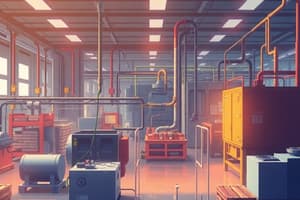Podcast
Questions and Answers
What is a major challenge in operations management related to customer expectations?
What is a major challenge in operations management related to customer expectations?
- Demand for quality products or services (correct)
- Increasing bureaucratic procedures
- Improving employee morale
- Rapidly changing technologies
Which aspect is NOT included in the scope of operations management?
Which aspect is NOT included in the scope of operations management?
- Process design
- Employee training programs (correct)
- Material handling
- Plant layout
What does the term 'plant layout' refer to in operations management?
What does the term 'plant layout' refer to in operations management?
- The financial analysis of production costs
- The design of organizational culture
- The physical arrangement of facilities (correct)
- The strategic plan for marketing
Why is the selection of plant and facility location considered a long-term capital decision?
Why is the selection of plant and facility location considered a long-term capital decision?
Which of the following best describes 'process design' in operations management?
Which of the following best describes 'process design' in operations management?
What role does material handling play in operations management?
What role does material handling play in operations management?
What is a common expectation of operations management from service industries like hotels and banks?
What is a common expectation of operations management from service industries like hotels and banks?
Which challenge involves adapting to environmental considerations in operations management?
Which challenge involves adapting to environmental considerations in operations management?
What is the primary function of manufacturing management?
What is the primary function of manufacturing management?
Which statement best illustrates the difference between manufacturing and production?
Which statement best illustrates the difference between manufacturing and production?
Which aspect is NOT typically associated with manufacturing?
Which aspect is NOT typically associated with manufacturing?
What is a key feature distinguishing operations management from production management?
What is a key feature distinguishing operations management from production management?
Which of the following is a characteristic of production management?
Which of the following is a characteristic of production management?
Why is tangibility significant in manufacturing?
Why is tangibility significant in manufacturing?
Which factor is essential for manufacturing but optional for production?
Which factor is essential for manufacturing but optional for production?
What does the term 'Unique Selling Proposition' (USP) refer to in the context of production management?
What does the term 'Unique Selling Proposition' (USP) refer to in the context of production management?
What is a primary objective of production planning and control?
What is a primary objective of production planning and control?
Which of the following is NOT typically a responsibility of quality control?
Which of the following is NOT typically a responsibility of quality control?
What does materials management primarily involve?
What does materials management primarily involve?
What is the role of maintenance management in production?
What is the role of maintenance management in production?
Which function is foundational in operations management?
Which function is foundational in operations management?
In finance for operations management, the main goal is to:
In finance for operations management, the main goal is to:
Which of the following describes a task of operations management?
Which of the following describes a task of operations management?
What should operations managers consistently seek to improve?
What should operations managers consistently seek to improve?
What role does the operations team play in the product design process?
What role does the operations team play in the product design process?
Which of the following tasks is NOT part of quality control?
Which of the following tasks is NOT part of quality control?
What is a key objective of strategic management in operations?
What is a key objective of strategic management in operations?
What should be done first in the quality control process?
What should be done first in the quality control process?
How does forecasting benefit the operations team?
How does forecasting benefit the operations team?
What type of analysis is performed to identify potential problems during the quality control process?
What type of analysis is performed to identify potential problems during the quality control process?
Which objective is typically NOT aligned with business goals in operations management?
Which objective is typically NOT aligned with business goals in operations management?
What is one of the first tasks of the operations team related to product design?
What is one of the first tasks of the operations team related to product design?
Flashcards
Manufacturing Management
Manufacturing Management
The process of transforming raw materials into tangible, sellable goods.
Production Management
Production Management
The process of creating products or goods (as utility). Quality is key.
Operations Management
Operations Management
Creating services for consumption or converting raw materials into finished services.
Manufacturing vs. Production
Manufacturing vs. Production
Signup and view all the flashcards
Production vs. Operations
Production vs. Operations
Signup and view all the flashcards
Scope of Production Management
Scope of Production Management
Signup and view all the flashcards
Scope of Operations Management
Scope of Operations Management
Signup and view all the flashcards
Production Management Focus
Production Management Focus
Signup and view all the flashcards
Production Planning and Control
Production Planning and Control
Signup and view all the flashcards
Operations Management Focus
Operations Management Focus
Signup and view all the flashcards
Quality Control
Quality Control
Signup and view all the flashcards
Operations Management Application
Operations Management Application
Signup and view all the flashcards
Operations Management Challenges
Operations Management Challenges
Signup and view all the flashcards
Materials Management
Materials Management
Signup and view all the flashcards
Plant Location Decisions
Plant Location Decisions
Signup and view all the flashcards
Maintenance Management
Maintenance Management
Signup and view all the flashcards
Plant Layout
Plant Layout
Signup and view all the flashcards
Operational Planning
Operational Planning
Signup and view all the flashcards
Material Handling
Material Handling
Signup and view all the flashcards
Finance in Operations
Finance in Operations
Signup and view all the flashcards
Difference Manufacturing/Service
Difference Manufacturing/Service
Signup and view all the flashcards
Product Design
Product Design
Signup and view all the flashcards
Process Design
Process Design
Signup and view all the flashcards
Operational Efficiency
Operational Efficiency
Signup and view all the flashcards
Operations Finance
Operations Finance
Signup and view all the flashcards
Market Research for Design
Market Research for Design
Signup and view all the flashcards
Quality Control Tasks
Quality Control Tasks
Signup and view all the flashcards
Product Forecasting
Product Forecasting
Signup and view all the flashcards
Business Strategy in Operations
Business Strategy in Operations
Signup and view all the flashcards
Operations Team Role
Operations Team Role
Signup and view all the flashcards
Quality Standards
Quality Standards
Signup and view all the flashcards
Operations Strategic Planning
Operations Strategic Planning
Signup and view all the flashcards
Study Notes
Introduction to Manufacturing and Production Management
- Manufacturing is the process of transforming raw materials into tangible, sellable goods.
- Production management focuses on converting raw materials into goods as a utility.
- Operations management creates services or transforms raw materials into services for consumption.
- Manufacturing is a subset of production, which is broader, encompassing operations, utility, and quality output.
Manufacturing vs. Production
- Manufacturing uses machinery to create finished goods, while production can or cannot use machinery.
- Manufacturing is more specific and focused, while production is more general.
- Tangibility is a key differentiator; manufacturing outputs are tangible, while production outputs can be either tangible or intangible.
Manufacturing vs. Operations
- Manufacturing focuses explicitly on creating finished goods, whereas operations management involves a wider range of activities, including service creation and both tangible and intangible goods.
- Production formulas (output/input) are definite in manufacturing and can create consumable products, unlike production that encompasses utility.
- Manpower and machinery are critical in manufacturing, though not always required in production.
Production vs. Operations
- Production Management focuses on creating finished goods aligned closely with production functions whereas Operations Management encompasses routine business processes and services delivery.
- The scope of production is limited because it only addresses goods, price, quantity, and quality.
- Operations management extends to include manpower planning, product price, quantity and quality like in production alongside the broader business function that includes other services and not just goods.
Operations Management Functions
- Plant Location and Facilities: Long-term decision involving plant and facility purchases to deliver customer service and utilities.
- Plant Layout: Physical arrangement of facilities to effectively deliver utilities to the customers.
- Material Handling: Carefully handling, transporting, and storing materials for production and operations.
- Product Design: Turning ideas into innovative product designs and services.
- Process Design: Flow diagram or layout showing the conversion of raw input to services output (workflow diagrams/decision trees/ process analyses).
- Production Planning and Control: Planning in advance the timing, volume, and procedures of production to deliver services at the right time, price, and specification.
- Quality Control: Maintaining product and service standards, detecting and fixing defects.
- Materials Management: Purchasing, controlling materials to optimize cost and ensure the efficient supply chain to the production process.
- Maintenance Management: Essential for machinery in production and operations.
Operating Systems
- Examples of operating systems (Hospital, Restaurant, Automobile Plant, University) are given, with brief descriptions of their inputs, conversion processes, and outputs.
Operational Areas and Decision Roles
- Process and Capacity Design: Addresses the required quantity/ procedures of products. What tools to use?
- Design of Goods and Services: Defining what products should be made and how to design them
- Managing Quality: How quality should be described and who is responsible for quality?
- Layout Strategy: Facility setup and location.
- Location Strategy: Deciding on a location.
- Human Resource and Job Design: Creating a fair work environment and job role standards.
- Inventory, Material Requirements Planning, and JIT: When to reorder & manufacture vs buy materials.
- Supply Chain Management: Who operates the e-commerce aspect of business?
Difference Between Manufacturing and Service Organizations
- Goods: Manufacturing produces physical products; services produce intangible outputs.
- Inventory: Manufacturing often has inventory; services do not.
- Demand: Manufacturing demands can often be postponed; service demand is often immediate.
- Contact with Customers: Production and service delivery interactions with customers.
- Response time: Customer tolerance and patience in terms of waiting time.
- Location: Manufacturing and Service Location.
- Quality Measurement: Manufacturing is objective, while service can be subjective.
- Consumption and Production time: Manufacturing can be simultaneous (materials and production time for a given product.) while service rarely is.
- Capacity & Resources: Labor and machinery are different for different companies
Functions of Operations and Skills Needed
- Operational Planning: Resourcefulness, financial planning, data interpretation.
- Finance: financial planning,
- Product Design: Data interpretation.
- Quality Control: Conflict management, data-driven decision making.
- Forecasting: Critical thinking, problem solving.
- Strategy: Critical thinking, problem solving,
- Supply Chain Management: Critical thinking, problem solving.
Specific Operational Tasks
- Operational Planning: Monitoring daily production, managing inventory, performance tracking, production planning.
- Finance: Creating budgets, finding investment opportunities, resource allocation.
- Product Design: Market research consolidation, communicating product/service development to designers.
- Quality Control: Performing risk analysis, quality standards, defect documentation.
- Forecasting: Predicting demand for products.
- Strategy: Prioritizing customer satisfaction, processes improvement, cost control.
Importance of Operations Management
- Motivation of team members
- Utilization of resources
- Enhanced collaboration
- Achievement of objectives
- Improved Productivity
Studying That Suits You
Use AI to generate personalized quizzes and flashcards to suit your learning preferences.




